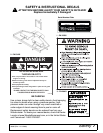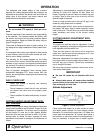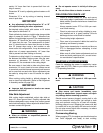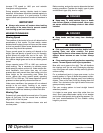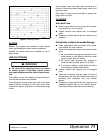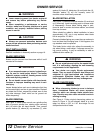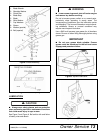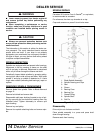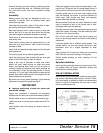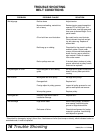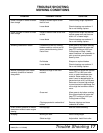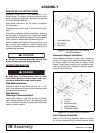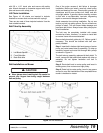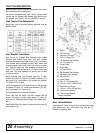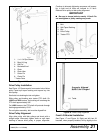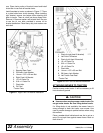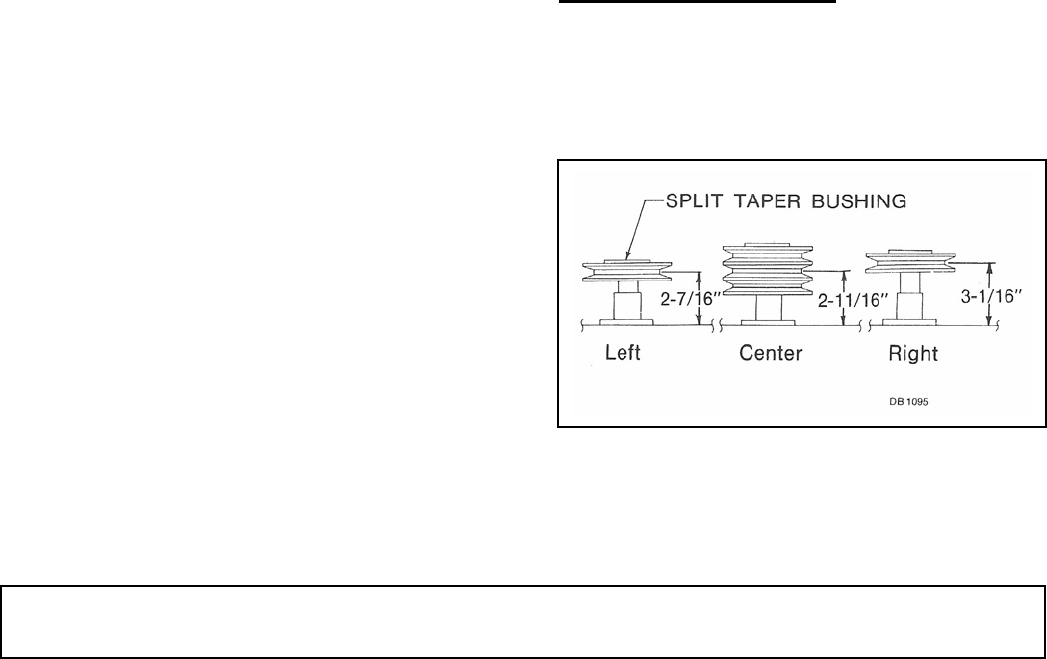
Dealer Service 15
32695 (Rev. 11/17/2006)
Remove bearing cups from housing by placing a punch
in slots provided and drive out. Alternate punch posi-
tion from side to side. Take care to prevent housing
damage.
Assembly
Bearing cones and cups are designed to mate. It is
important to position them so bearing cones taper
mates with cup taper.
Lubricate new cups with a light oil. Place them in spin-
dle housing with tapers toward the outside.
Seat cups securely with a press or place a large soft
drift on the flat lip of cup and drive them into housing
until seated against machined shoulder of housing.
Polish areas of shaft and sleeve where seals will seat
with emery cloth.
Place bottom bearing cone on spindle shaft so it will
mate with cup, and press on until it seats on bottom
shoulder of shaft.
Insert shaft and bearing through bottom of housing and
seat against cup.
Fill housing cavity with a medium grade grease.
Install top bearing on shaft to mate with top cone and
press on shaft until there is room for sleeve.
Apply a thin coat of Permatex to shaft area where
sleeve will seat. Install sleeve on shaft and press
sleeve and bearing down shaft until all end play is
removed (similar to adjusting front wheel bearings on
an automobile). Check by spinning spindle. It should
turn freely. If it is too tight, hold spindle housing and hit
spindle shaft with a lead hammer. Press again until the
proper adjustment is obtained.
Be careful not to over-tighten bearings. Proper bearing
adjustment is essential to good bearing lift.
IMPORTANT
■ Improper positioning of seals can cause seal
and spindle damage.
Proper seal installation is important. An improperly
installed seal will leak and could cause bearing failure.
Pull the rubber portion of seal back and locate spring.
Lightly coat area of housing where seals seat with Per-
matex.
Install bottom seal with spring up toward center of
housing.
Place seal squarely on housing and select pipe or tub-
ing with an OD that will set on outside edge of seal. A
tubing with an OD that is too small will bow seal cage.
Carefully guide seal lip over shaft and carefully press
seal into housing. Be careful to prevent distortion to
metal cage. Seal should seat firmly and squarely
against machined shoulder in housing.
Make sure seal lip did not roll under. Distortion to seal
case or damage to seal lip will cause seal to leak.
Damaged seals must be replaced.
Carefully press top seal into housing with spring up and
away from center of housing. Top seal should be flush
with up to 1/16" above housing.
Drill a 3/16" hole 9/32" down from top of sleeve and
drive roll pin through sleeve and shaft to hold bearing
adjustment.
Lubricate spindle with a medium grade grease. Turn
spindle bottom up and vent bottom seal with a dull
instrument such as a tongue depressor or letter
opener.
Apply grease until it comes out where you are venting
seal. Use care to prevent cutting or nicking seal.
Rotate spindle housing on shaft, checking for free
movement.
Spindle Installation
Insert spindle up through bottom of mower frame. Posi-
tion grease fitting for proper lubrication access and
install the four mounting bolts.
PULLEY INSTALLATION
Install pulley onto spindle shaft. Install split taper bush-
ing and key. Alternately tighten bolts to 12 lbs-ft. Check
to be sure pulley is located on shaft to the dimensions
shown in Figure 8. Dimensions are from top of mower
frame to pulley center line.
Figure 8. Pulley Installation



